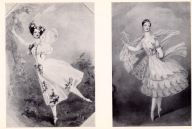 Storytime
Storytime
The storylines taken up in the ballets of the eighteen-twenties and -thirties fulfilled this desire for escape, calling on the exotic (Aladdin, ou la Lampe merveilleuse of 1822) and the mystical to distract middle-class audiences. The most famous ballets falling under this heading was La Sylphide (1832). The action of this tale revolves around a mystical creature of air and light, a sylph, whose attempts to wile a young man away from his fiancé and community, culminate in her tragic death (Banes & Carroll 1997). Stories of this kind dominated the stage during these years, responding to the growing desire for divertissement from the realities of industrialization, materialism and commercialization. These storylines, revolving around the actions of otherworldly female creatures, also evoked the Romantic ideals of femininity and the fragility of youthful beauty, which were enhanced by the costume of the ballerina. However, these tragic tales of ephemeral, female beauties required dancers to find ways to affect the gravity-defying airiness of the otherworldly character of sylphs, nymphs, and fairies. The integration of pointe work into the repertoire of the ballerina fulfilled this role.